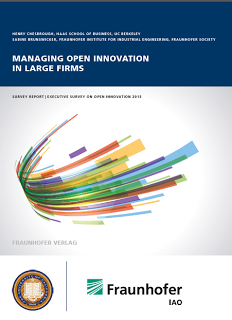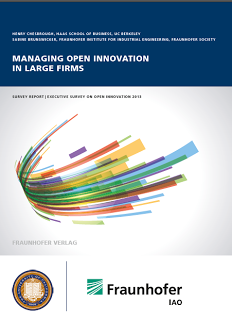Open Innovation On the Rise! Does it Add Value?

 Ever wonder how your company stacks up in terms of open innovation adoption, practices, and maturity? Earlier this year, the tenth anniversary of the publication his landmark book Open Innovation, Henry Chesbrough teamed up with Sabine Brunswicker of Fraunhofer Institute for Industrial Engineering to publish results of what is likely the first large-scale quantitative survey of the adoption of open innovation in large companies. The overall conclusion of their survey, entitled 'Managing Open Innovation in Large Firms,' is that open innovation is on rise. There are differences among various practices, among industries, and between inbound open innovation vs. outbound open innovation. And success measures of value are still qualitative vs. qualitative. However, the authors suggest that overall, firms are intensifying their efforts as well as attaching greater strategic importance to open innovation.
Ever wonder how your company stacks up in terms of open innovation adoption, practices, and maturity? Earlier this year, the tenth anniversary of the publication his landmark book Open Innovation, Henry Chesbrough teamed up with Sabine Brunswicker of Fraunhofer Institute for Industrial Engineering to publish results of what is likely the first large-scale quantitative survey of the adoption of open innovation in large companies. The overall conclusion of their survey, entitled 'Managing Open Innovation in Large Firms,' is that open innovation is on rise. There are differences among various practices, among industries, and between inbound open innovation vs. outbound open innovation. And success measures of value are still qualitative vs. qualitative. However, the authors suggest that overall, firms are intensifying their efforts as well as attaching greater strategic importance to open innovation.
The study
The study focused on top senior executives in R&D, technology, operations, and business development, including CTOs, COOs, and CEOs. Types of companies include manufacturing and service sectors, including both high-tech and low-tech enterprises. The study found that 'open innovation is most widely adopted in high-tech manufacturing sectors and wholesale, trade, and retail. Low-tech manufacturing sectors and financial services show the lowest rates of adoption.
Adoption of open innovation
The study found that open innovation is on the rise. Open innovation is being practiced with increased intensity, with 71% of respondents reporting increased management support. At the same time, open innovation efforts are not being abandoned. The median number of years of open experience in the survey was five, and more than 30% of the companies surveyed claim to have been practicing open innovation since before the term was coined in 2003. There are two types of open innovation: 'inbound,' where companies take input in from external sources; and 'outbound,' where companies provide contributions (products, intellectual property, etc.) to external sources. Companies practice inbound open innovation to a much greater extent than outbound, leading the researchers to use the term 'net-takers' to describe the firms.
What form of open innovation is practiced?
The three most widely used open innovation practices are 'customer and consumer co-creation,' informal networking,' and 'university research grants,' and the three most prevalent inbound partners are customers, universities, and suppliers. On the other hand, open innovation practices with great media buzz, such as prize competitions, crowd-sourcing, and intermediaries, are the least widely used. This suggests to me that companies are more likely form open innovation partnerships and alliances with known external entities than with anonymous parties.
Open innovation as a strategic objective
Companies most often use open innovation as a means of establishing new partnerships, exploring new technological trends, and identifying new business opportunities.They use it the least to reduce R&D costs per project. Open innovation, therefore, is seen to be more of an opportunity-driven vs. a cost-cutting endeavor.
Managing open innovation
Open innovation is still decentralized in most organizations, though increasingly, resources are being devoted to open innovation, with position titles such as VP of Open Innovation and Open Innovation Manager becoming more common. The median budget for an open innovation program is two million, and the median resources are 20. Senior executives agree that practices need improvement. The study found that 'new practices for managing open innovation have not been systemically adopted' and that internal organizational challenges remain a barrier to a more systemic approach.
How to measure open innovation success?
Senior executives believe that open innovation adds value, and not surprisingly, overall satisfaction is positively correlated to the level of top management support. Also not surprisingly, firms that have been experimenting with open innovation for longer periods show higher satisfaction. This suggests that there is a trial and error component and that a sustained effort will yield an approach that adds value to the company. What is 'value'? While there is no universally lauded approach to measuring success, three of the most common measures are: the degree to which there is external contribution; the cost/benefit of working with external partners; and the number of external partners.
Key takeaways
- Open innovation is on the rise
- Firms are more likely to take (inbound) than they are to give (outbound)
- Open innovation is not a substitute for internal R&D
- Internal barriers remain to organizational support to open innovation
- As open innovation practices mature, measures for success need to be established to demonstrate value.
 Ivy Eisenberg is founder of Our IdeaWorks, an Innovation and Lean Customer Research' consultancy that helps companies connect to customers and other stakeholders to discover business opportunities, accelerate growth, and build and deliver successful products and services. Ivy has more than 25 years of experience in the Front End of Innovation, user interaction design, and software product and project management. She has worked in healthcare, financial services, B2B, consumer goods, and telecommunications sectors. Ivy is also an award-winning humor writer and storyteller, with an MBA in Marketing, Entrepreneurship and Innovation from NYU's Stern School of Business.
Ivy Eisenberg is founder of Our IdeaWorks, an Innovation and Lean Customer Research' consultancy that helps companies connect to customers and other stakeholders to discover business opportunities, accelerate growth, and build and deliver successful products and services. Ivy has more than 25 years of experience in the Front End of Innovation, user interaction design, and software product and project management. She has worked in healthcare, financial services, B2B, consumer goods, and telecommunications sectors. Ivy is also an award-winning humor writer and storyteller, with an MBA in Marketing, Entrepreneurship and Innovation from NYU's Stern School of Business.